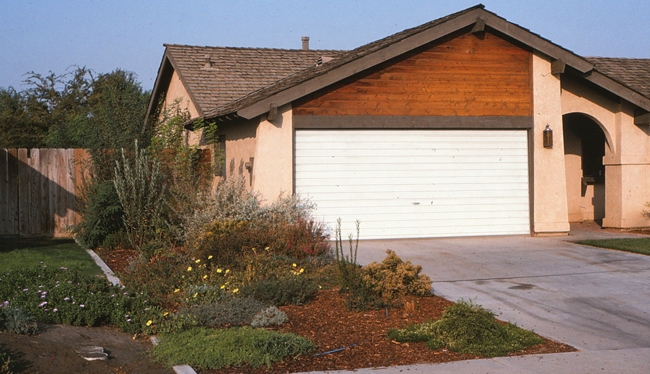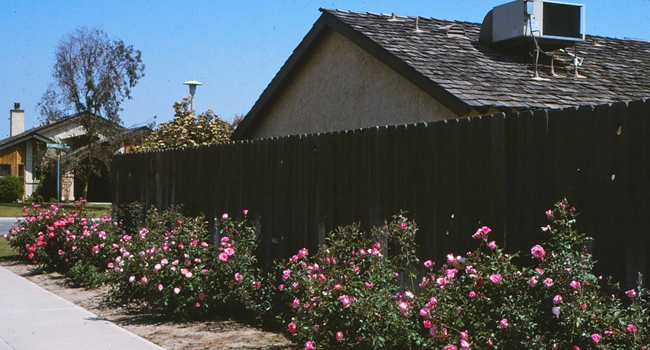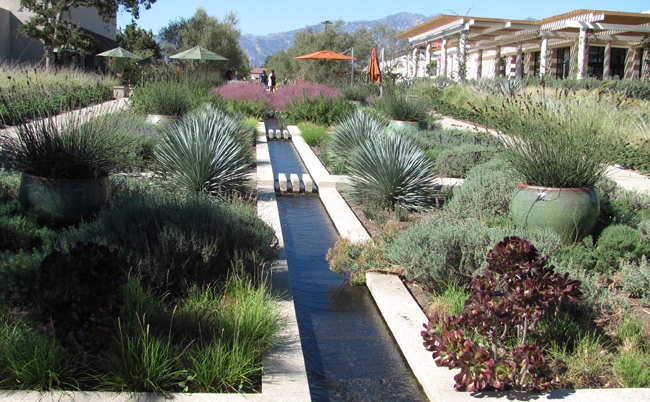By John Karlik, UC Cooperative Extension, Environmental Horticulture/Environmental Science Advisor, Kern County
As California enters another dry summer, the supply and use of water are once again becoming topics of immediate concern. Statewide, agriculture dominates use of developed water — meaning water which is moved through pipes at some point. In urban areas, about half of developed water is used outdoors, and of that fraction about half is used for landscape irrigation.
That half is an important fraction in Los Angeles and other urban areas. Across the state, homeowners may be interested in saving money on water bills, improving plant health, limiting weeds, and being ecologically responsible while still having an attractive, low-maintenance landscape.
There are several approaches to landscape management that can save water. Some are relatively simple, such as adjusting irrigation schedules. Others require more cost and time, such as replacing some plant materials with others or modifying an irrigation system.
In the 1990s, there were many meetings and attention given to the concept of xeriscape, which is a water-conserving landscape. Seven principles of xeriscape were enunciated, among them plant selection, use of mulches, and so forth. Often, when someone asks about reducing landscape irrigation, the first thought or question is about replacing plants with others thought to require less water.
The key to water savings, however, is irrigation scheduling, which is a combination of frequency and duration. That means how often the system is run and how much water is applied each time. In fact, all possible landscape modifications are directed toward being able to make changes in how much water is applied, because without reducing applied water by changing irrigation settings no water will be saved.
Around 1990, I did a case study in my own home landscape in Bakersfield, California, which is a warm-summer area, to measure how various changes in the landscape affected water use. I tracked water use through monthly water bills, and knew how much water the previous owner had used on a month-by-month basis.
When I moved in to the house, I immediately began a four-phase plan to change the landscape and evaluate corresponding water use. Goals were to conserve water, minimize maintenance, lessen the need for herbicides and insecticides, and evaluate less common plants thought to be water conserving. The house had a water meter, and I recorded the monthly values.
The first phase focused on assessing the property. The landscape had 4,880 square feet of well-maintained hybrid bermudagrass with additional areas of border plantings of annual flowers and shrubs.
Phase two involved changing irrigation scheduling with no other landscape modifications. I began by conducting a water audit by placing small containers around the yard during a watering cycle and measuring the amount of water in the containers. I used these data to determine precipitation rate; that is, how much water sprinklers delivered per given time period. Then, I checked UC data for historic reference evapotranspiration (ETo), which is the amount of water an unstressed area of cool season turfgrass uses. I adjusted the irrigation schedule accordingly.
This change – the water audit plus changing sprinkler timer settings based on ETo – was the least expensive alteration. Yet it ultimately proved to be the most effective in reducing water use, resulting in a 33% savings in outdoor water use compared to the baseline year.
In phase three, turf was replaced and the total turf area reduced. Bermudagrass was sod cut and removed and replaced with ‘El Toro' zoysia, a UC release. The main reason for turf replacement was not water conservation, at which bermudagrass excels, but rather to reduce maintenance and to observe ‘El Toro' in a residential setting, since at the time it was quite new.

The bermudagrass on the south side of the driveway was replaced with plants thought to be water conserving from an Arizona nursery. In the side yard along the street, bermudagrass between a fence and sidewalk was replaced with landscape roses watered by drip irrigation. The new turf area was 3,260 square feet, 67% of the original turf area. Water saved following these modifications was small, only 4% less than in year two. 
Overall, through these modifications, water use in the landscape was reduced to 55% of its initial value. As noted, the greatest savings occurred by simply adjusting clock settings to better correspond to plant water needs. Other benefits were reduction in maintenance time and improved ease of care of the landscape.
